类和对象的定义以及使用
1. 类和对象的基本概念
1.1 JAVA是面向对象语言
Java是一门纯面向对象的语言(Object Oriented Program,简称OOP),在面向对象的世界里,一切皆为对象。面向对象是解决问题的一种思想,主要依靠对象之间的交互完成一件事情。
1.2 类和对象的描述
在Java中万物皆对象,一切都围绕对象进行:
类:把具有相同属性和行为的一类对象抽象为类。类是抽象概念,如人类、犬类等,无法具体到每个实体。
对象:某个类的一个实体,当有了对象后,这些属性便有了属性值,行为也就有了相应的意义。
类是对象的抽象,而对象是类的具体实例。类是抽象的,不占用内存,而对象是具体的,占用存储空间。
做个比方:类实例化出对象就像现实中使用建筑设计图建造出房子,类就像是设计图,只设计出需要什么东西,但是并没有实体的建筑存在,同样类也只是一个设计,实例化出的对象才能实际存储数据,占用物理空间。
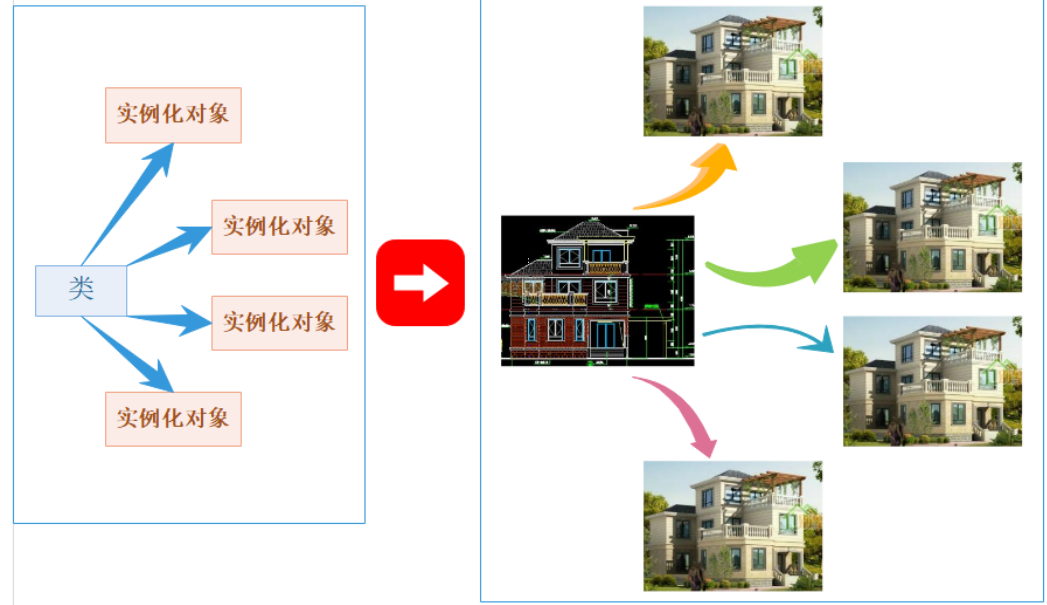
2. 类与对象的定义与使用
面向对象程序设计关注的是对象,而对象是现实生活中的实体,比如:狗。但是狗计算机并不认识,需要开发人员告诉给计算机什么是狗。
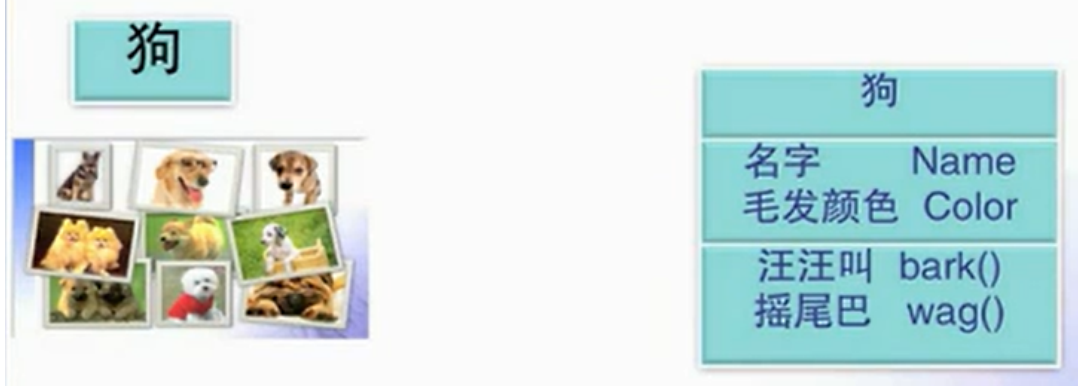
上图右侧就是对狗简单的描述,该过程称为对狗对象(实体)进行抽象(对一个复杂事物的重新认知),但是这些简化的抽象结果计算机也不能识别,开发人员可以采用某种面向对象的编程语言来进行描述,比如:Java语言。
2.1 类的定义格式
在java中定义类时需要用到class关键字,class为定义类的关键字,ClassName为类的名字,{}中为类的主体。具体语法如下:
// 创建类
class ClassName{
field; // 字段(属性) 或者 成员变量
method; // 行为 或者 成员方法
}
类中包含的内容称为类的成员。属性主要是用来描述类的,称之为类的成员属性或者类成员变量。方法主要说明类具有哪些功能,称为类的成员方法。
2.2 类的实例化(对象的创建)
定义了一个类,就相当于在计算机中定义了一种新的类型,有了这些自定义的类型之后,就可以使用这些类来定义实例(或者称为对象)。用类类型创建对象的过程,称为类的实例化,在java中采用new关键字,配合类名来实例化对象。
类名称 对象名称 = new 类名称();
PetDog dogs = new PetDog();
注意事项
new 关键字用于创建一个对象的实例.
2.3 举个例子
采用Java语言定义狗类型,并创建一个狗的对象
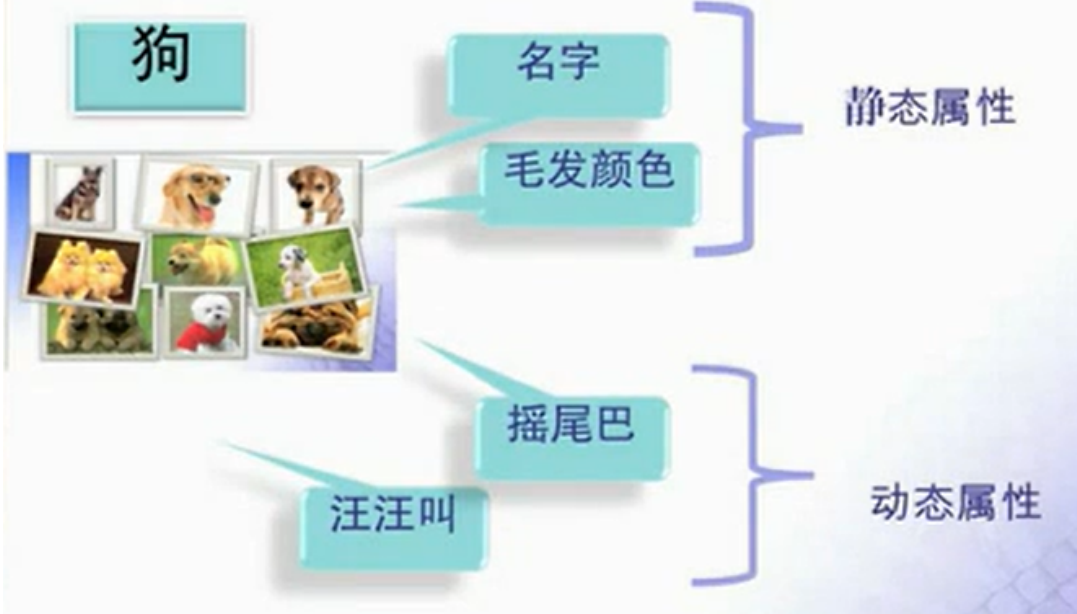
class PetDog {
//成员变量(实例变量),在堆中的每个对象中存储,通过对象调用
// 狗的属性
public String name;//名字
public String color;//颜色
//成员方法(实例方法),在JVM的方法区中存储,通过对象调用
// 狗的行为
public void barks() {
System.out.println(name + ": 旺旺旺~~~");
}
public void wag() {
System.out.println(name + ": 摇尾巴~~~");
}
}

public class Main{
public static void main(String[] args) {
//创建一个实例化对象,通过new实例化对象
PetDog dogh = new PetDog();
//通过对象来调用实例变量、成员方法
dogh.name = "阿黄";
dogh.color = "黑黄";
dogh.barks();
dogh.wag();
PetDog dogs = new PetDog();
dogs.name = "阿黄";
dogs.color = "黑黄";
dogs.barks();
dogs.wag();
}
}
输出结果:
阿黄: 旺旺旺~~~
阿黄: 摇尾巴~~~
赛虎: 旺旺旺~~~
赛虎: 摇尾巴~~~
注意事项:
- 类名注意采用大驼峰定义
- 一般一个文件当中只定义一个类
- main方法所在的类一般要使用public修饰(注意:Eclipse默认会在public修饰的类中找main方法)
- public修饰的类必须要和文件名相同 ,并且不要轻易去修改public修饰的类的名称。
- 使用 . 来访问对象中的属性和方法.
- 同一个类可以创建多个实例.
3. 对象的构造及初始化
3.1构造方法
3.1.1构造方法的定义
构造方法(也称为构造器)是一个特殊的成员方法,名字必须与类名相同,在创建对象时,由编译器自动调用,并且在整个对象的生命周期内只调用一次。
构造方法规则:
- 名字与类名相同,没有返回值类型,设置为void也不行
- 一般情况下使用public修饰
- 一个类中至少存在一个构造方法,若没有显示定义,编译器会生成一个默认的无参构造
示例代码:
public class Date {
public int year;
public int month;
public int day;
public Date(int year, int month, int day){
this.year = year;
this.month = month;
this.day = day;
System.out.println("Date(int,int,int)方法被调用了");
}
public void printDate(){
System.out.println(year + "-" + month + "-" + day);
}
public static void main(String[] args) {
// 此处创建了一个Date类型的对象,并没有显式调用构造方法
Date d = new Date(2021,6,9); // 输出Date(int,int,int)方法被调用了
d.printDate(); // 2021-6-9
}
}
使用new关键字产生一个对象时,大致分为以下两步(4.2中有详细过程):
(1)为对象在堆中分配空间(空间大小由该类中成员变量的属性决定)
(2)调用对象的构造方法为对象成员变量赋值(当构造方法调用结束后,该对象初始化完成),构造方法的作用就是对对象中的成员进行初始化,并不负责给对象开辟空间。
3.1.2 构造方法的特性
- 名字必须与类名相同
- 没有返回值类型,设置为void也不行
- 创建对象时由编译器自动调用,并且在对象的生命周期内只调用一次(相当于人的出生,每个人只能出生一次)
- 构造方法可以重载(用户根据自己的需求提供不同参数的构造方法)
class Date {
public int year;
public int month;
public int day;
// 无参构造方法
public Date(){
this.year = 1900;
this.month = 1;
this.day = 1;
}
// 带有三个参数的构造方法
public Date(int year, int month, int day) {
this.year = year;
this.month = month;
this.day = day;
}
上述两个构造方法:名字相同,参数列表不同,因此构成了方法重载。
- 如果用户没有显式定义,编译器会生成一份默认的构造方法,生成的默认构造方法一定是无参的。
class Date {
public int year;
public int month;
public int day;
public void printDate(){
System.out.println(year + "-" + month + "-" + day);
}
public static void main(String[] args) {
Date d = new Date();
d.printDate();
}
}

上述Date类中,没有定义任何构造方法,编译器会默认生成一个不带参数的构造方法。
- 如果用户显式定义了构造方法,编译器则不会再生成构造方法。
class Date {
public int year;
public int month;
public int day;
public Date(int year, int month, int day) {
this.year = year;
this.month = month;
this.day = day;
}
}
public class Test{
public static void main(String[] args) {
// 如果编译器会生成,则生成的构造方法一定是无参的,则此处创建对象是可以通过编译的
// 但实际情况是:编译期报错
Date d = new Date();
}
}

4.2 默认初始化
public class Date {
public int year;
public int month;
public int day;
public Date() {
// 成员变量在定义时,并没有给初始值, 为什么就可以使用呢?
System.out.println(this.year);
System.out.println(this.month);
System.out.println(this.day);
}
public static void main(String[] args) {
// 此处a没有初始化,编译时报错:
// Error:(24, 28) java: 可能尚未初始化变量a
// int a;
// System.out.println(a);
Date d = new Date();
}
}

我们观察上述代码部分,发现局部变量在使用时必须要初始化,而成员变量可以不用。要搞清楚这个问题的答案,就需要知道 new 关键字背后所发生的一些事情:
Date d = new Date();
在程序层面只是简单的一条语句,在JVM层面需要做好多事情,下面简单介绍下:
-
检测对象对应的类是否加载了,如果没有加载则加载
-
为对象分配内存空间
-
处理并发安全问题
比如:多个线程同时申请对象,JVM要保证给对象分配的空间不冲突 -
初始化所分配的空间
即:对象空间被申请好之后,对象中包含的成员已经设置好了初始值,比如:
| 数据类型 | 默认值 |
|---|---|
| byte | 0 |
| char | ‘\u0000’ |
| short | 0 |
| int | 0 |
| long | 0L |
| boolean | false |
| float | 0.0f |
| double | 0.0 |
| reference(引用类型) | null |
- 设置对象头信息
- 调用构造方法,给对象中各个成员赋值
5.4 就地初始化
在声明成员变量时,就直接给出了初始值。
public class Date {
public int year = 1900;
public int month = 1;
public int day = 1;
public Date(){
}
public Date(int year, int month, int day) {
}
public static void main(String[] args) {
Date d1 = new Date(2021,6,9);
Date d2 = new Date();
}
}
注意:代码编译完成后,编译器会将所有给成员初始化的这些语句添加到各个构造函数中
4.this 关键字(表示当前对象的引用)
4.1 this.XXX调用当前对象的属性/字段/成员变量
class Date {
public int year;
public int month;
public int day;
public Date(int year, int month, int day) {
year = year;
month= month;
day = day;
}
public void printDate() {
System.out.println(year + "/" + month + "/" + day);
}
}
public class Test{
public static void main(String[] args) {
// 构造日期类型的对象 d1
Date d1 = new Date(2020, 9, 15);
// 打印日期中的内容
d1.printDate();
}
}

以上代码定义了一个日期类,然后main方法中创建了三个对象,并通过Date类中的构造方法对对象成员变量进行初始化,但输出结果仍是默认值。
原因是这里传入的形参名 year和 month,day与 赋值的名字相同 ,编译器并不知情 ,会按照就近匹配原则,由于局部变量优先 ,此时就会出现自己赋值给自己的情况 。

this关键字表示当前对象的引用,使用this关键字可以调用当前对象的成员变量
class Date {
public int year;
public int month;
public int day;
public Date(int year, int month, int day){
this.year = year;
this.month = month;
this.day = day;
}
public void printDate(){
System.out.println(this.year + "/" + this.month + "/" + this.day);
}
}
public class Test{
public static void main(String[] args) {
Date d1 = new Date(2020, 9, 15);
// 打印日期中的内容
d1.printDate();
}
}

4.2 this.xxx()调用当前对象的成员方法
class Date {
public int year;
public int month;
public int day;
public Date(int year, int month, int day){
this.year = year;
this.month = month;
this.day = day;
}
public void init() {
System.out.println("Date的int()方法");
}
public void printDate(){
//init()方法是成员方法,必须通过对象调用
//this表示对象的引用,调用成员方法时不写,编译时也会自动加上
init();//等价于this.init();
System.out.println("Date的printDate()方法");
System.out.println(this.year + "/" + this.month + "/" + this.day);
}
}
public class Test{
public static void main(String[] args) {
Date d1 = new Date(2020, 9, 15);
// 打印日期中的内容
d1.printDate();
}
}

4.3 this(XX,…)调用当前对象的其他构造方法
构造方法中,可以通过this调用其他构造方法来简化代码
class Date {
public int year;
public int month;
public int day;
// 无参构造方法--内部给各个成员赋值初始值,该部分功能与三个参数的构造方法重复
// 此处可以在无参构造方法中通过this调用带有三个参数的构造方法
// 但是this(1900,1,1);必须是构造方法中第一条语句
public Date(){
//System.out.println(year); 注释取消掉,编译会失败,this()是构造方法中第一条语句
this(1900, 1, 1);
//等价于
//this.year = 1900;
//this.month = 1;
//this.day = 1;
}
// 带有三个参数的构造方法
public Date(int year, int month, int day) {
this.year = year;
this.month = month;
this.day = day;
}
}
注意事项:
- this(…)必须是构造方法中第一条语句
- 不能形成环
public Date(){
this(1900,1,1);
}
public Date(int year, int month, int day) {
this();
}
/*无参构造器调用三个参数的构造器,而三个参数构造器有调用无参的构造器,形成构造器的递归调用
编译报错:Error:(19, 12) java: 递归构造器调用*/
4.4 this引用
this引用指向当前对象(成员方法运行时调用该成员方法的对象),在成员方法中所有成员变量的操作,都是通过该引用去访问。只不过所有的操作对用户是透明的,即用户不需要来传递,编译器自动完成。
class Date {
public int year;
public int month;
public int day;
public void setDay(int year, int month, int day){
this.year = year;
this.month = month;
this.day = day;
}
public void printDate(){
System.out.println(this.year + "/" + this.month + "/" + this.day);
}
}
public class Test{
public static void main(String[] args) {
Date d = new Date();
d.setDay(2020,9,15);
d.printDate();
}
}
注意:this引用的是调用成员方法的对象。
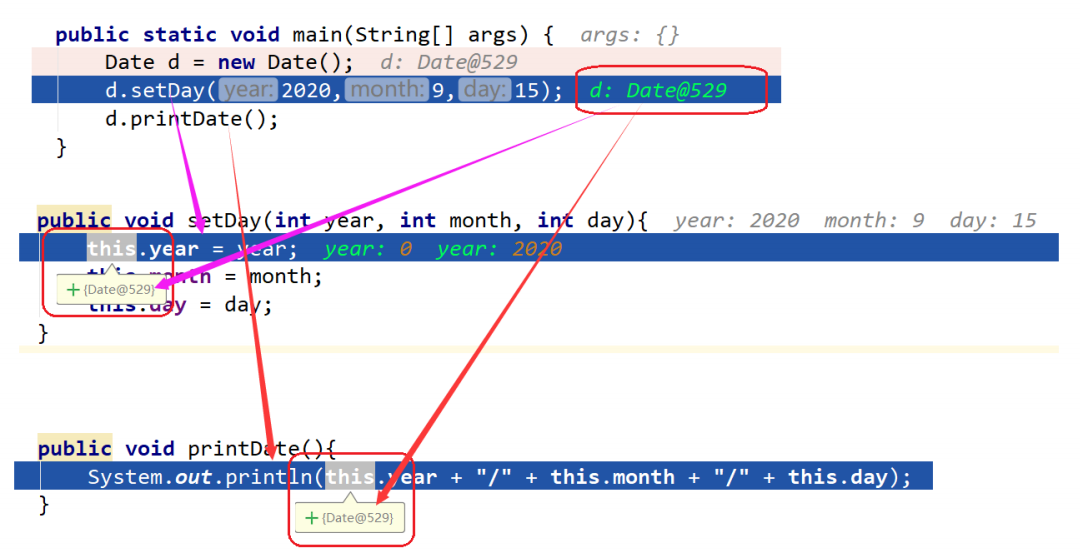
- this的类型:对应类类型引用,即哪个对象调用就是哪个对象的引用类型
- this只能在"成员方法"中使用
- 在"成员方法"中,this只能引用当前对象,不能再引用其他对象
- this是“成员方法”第一个隐藏的参数,编译器会自动传递,在成员方法执行时,编译器会负责将调用成员方法对象的引用传递给该成员方法,this负责来接收
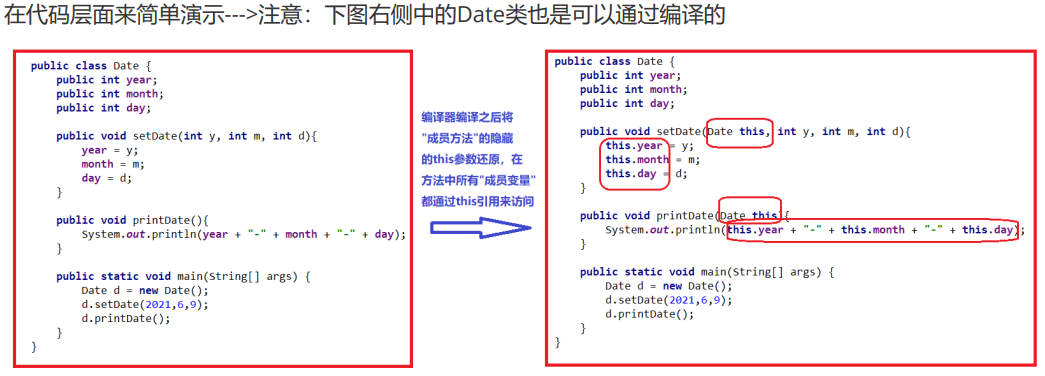
5.对象的打印
class Person {
String name;
String gender;
int age;
public Person(String name, String gender, int age) {
this.name = name;
this.gender = gender;
this.age = age;
}
}
public class Test{
public static void main(String[] args) {
Person person = new Person("Jim","男", 18);
System.out.println(person);
}
}
// 打印结果:day20210829.Person@1b6d3586
如果想要默认打印对象中的属性该如何处理呢?答案:重写toString方法即可。
class Person {
String name;
String gender;
int age;
public Person(String name, String gender, int age) {
this.name = name;
this.gender = gender;
this.age = age;
}
@Override
public String toString() {
return "[" + name + "," + gender + "," + age + "]";
}
}
public class Test{
public static void main(String[] args) {
Person person = new Person("Jim","男", 18);
System.out.println(person);
}
}
// 输出结果:[Jim,男,18]
6. 封装
6.1 封装的概念
面向对象程序三大特性:封装、继承、多态。而类和对象阶段,主要研究的就是封装特性.
封装:将数据和操作数据的方法进行有机结合,隐藏对象的属性和实现细节,仅对外公开接口来和对象进行交互
6.2 访问限定符
Java中主要通过类和访问权限来实现封装:类可以将数据以及封装数据的方法结合在一起,更符合人类对事物的认知,而访问权限用来控制方法或者字段能否直接在类外使用。Java中提供了四种访问限定符:
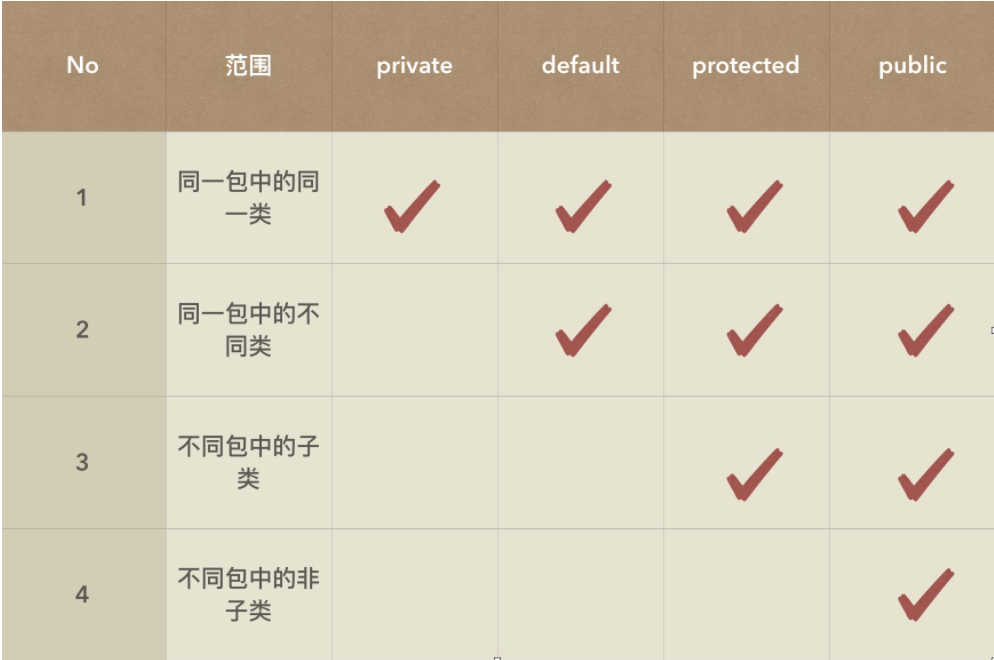
【说明】
- protected主要是用在继承中
- default权限指:什么都不写时的默认权限
- 访问权限除了可以限定类中成员的可见性,也可以控制类的可见性
public class Computer {
private String cpu; // cpu
private String memory; // 内存
public String screen; // 屏幕
String brand; // 品牌---->default属性
public Computer(String brand, String cpu, String memory, String screen) {
this.brand = brand;
this.cpu = cpu;
this.memory = memory;
this.screen = screen;
}
public void Boot(){
System.out.println("开机~~~");
}
public void PowerOff(){
System.out.println("关机~~~");
}
public void SurfInternet(){
System.out.println("上网~~~");
}
}
public class TestComputer {
public static void main(String[] args) {
Computer p = new Computer("HW", "i7", "8G", "13*14");
System.out.println(p.brand); // default属性:只能被本包中类访问
System.out.println(p.screen); // public属性: 可以任何其他类访问
// System.out.println(p.cpu); //err, private属性:只能在Computer类中访问,不能被其他类访问
}
}
注意:一般情况下成员变量设置为private,成员方法设置为public。
7. static关键字
7.1 static修饰成员变量
static修饰的成员变量,称为静态成员变量,静态成员变量最大的特性:不属于某个具体的对象,是所有对象所共享的。
【静态成员变量特性】
1. 不属于某个具体的对象,是类的属性,所有对象共享的,不存储在某个对象的空间中
2. 既可以通过对象访问,也可以通过类名访问,但一般更推荐使用类名访问
3. 类变量存储在方法区当中
4. 生命周期伴随类的一生(即:随类的加载而创建,随类的卸载而销毁)
public class Student{
public String name;
public String gender;
public int age;
public double score;
public static String classRoom = "Bit306";
// ...
public static void main(String[] args) {
// 静态成员变量可以直接通过类名访问
System.out.println(Student.classRoom);
Student s1 = new Student("Li leilei", "男", 18, 3.8);
Student s2 = new Student("Han MeiMei", "女", 19, 4.0);
Student s3 = new Student("Jim", "男", 18, 2.6);
// 也可以通过对象访问:但是classRoom是三个对象共享的
System.out.println(s1.classRoom);
System.out.println(s2.classRoom);
System.out.println(s3.classRoom);
}
}
调试方式运行上述代码,然后在监视窗口中可以看到,静态成员变量并没有存储到某个具体的对象中。
7.2 static修饰成员方法
一般类中的数据成员都设置为private,而成员方法设置为public,那设置之后,Student类中classRoom属性如何在类外访问呢?
public class Student{
private String name;
private String gender;
private int age;
private double score;
private static String classRoom = "Bit306";
// ...
}
public class TestStudent {
public static void main(String[] args) {
System.out.println(Student.classRoom);
}
}
编译失败:
Error:(10, 35) java: classRoom 在 extend01.Student 中是 private 访问控制
Java中,被static修饰的成员方法称为静态成员方法,是类的方法,不是某个对象所特有的。静态成员一般是通过静态方法来访问的。
public class Student{
// ...
private static String classRoom = "Bit306";
// ...
public static String getClassRoom(){
return classRoom;
}
}
public class TestStudent {
public static void main(String[] args) {
System.out.println(Student.getClassRoom());
}
}
输出:Bit306
【静态方法特性】
1. 不属于某个具体的对象,是类方法
2. 可以通过对象调用,也可以通过类名.静态方法名(…)方式调用,更推荐使用后者
3. 不能在静态方法中访问任何非静态成员变量
public static String getClassRoom(){
System.out.println(this);
return classRoom;
}
// 编译失败:Error:(35, 28) java: 无法从静态上下文中引用非静态 变量 this
public static String getClassRoom(){
age += 1;
return classRoom;
}
// 编译失败:Error:(35, 9) java: 无法从静态上下文中引用非静态 变量 age
4. 静态方法中不能调用任何非静态方法,因为非静态方法有this参数,在静态方法中调用时候无法传递this引用
public static String getClassRoom(){
doClass();
return classRoom;
}
// 编译报错:Error:(35, 9) java: 无法从静态上下文中引用非静态 方法 doClass()
5. 静态方法无法重写,不能用来实现多态
7.4 static成员变量初始化
注意:静态成员变量一般不会放在构造方法中来初始化,构造方法中初始化的是与对象相关的实例属性,静态成员变量的初始化分为两种:就地初始化 和 静态代码块初始化。
- 就地初始化
就地初始化指的是:在定义时直接给出初始值
public class Student{
private static String classRoom = "Bit306";
// ...
}
- 静态代码块初始化
public class Student{
private static String classRoom;
// 静态代码块
static {
classRoom = "bit306";
System.out.println("I am static init()!");
}
本文来自互联网用户投稿,该文观点仅代表作者本人,不代表本站立场。本站仅提供信息存储空间服务,不拥有所有权,不承担相关法律责任。 如若内容造成侵权/违法违规/事实不符,请联系我的编程经验分享网邮箱:chenni525@qq.com进行投诉反馈,一经查实,立即删除!
- Python教程
- 深入理解 MySQL 中的 HAVING 关键字和聚合函数
- Qt之QChar编码(1)
- MyBatis入门基础篇
- 用Python脚本实现FFmpeg批量转换
- mmc0: Timeout waiting for hardware interrupt.
- android自定义来电秀UI
- centos7安装node-v18版本
- 部署可道云网盘的一个漏洞解决
- “一种1,4丁炔二醇纯化除铜装置”的实用新型专利
- 工智能基础知识总结--特征工程之特征选择
- 【pyqt6】用pyqt做一个点菜小程序
- k8s---pod控制器
- 编程笔记 html5&css&js 021 JavaScript
- RTC讲解